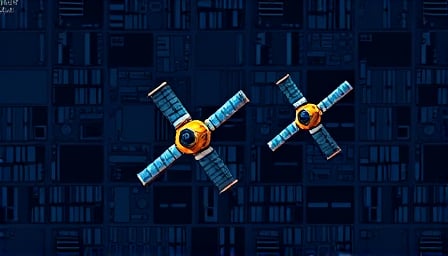Corporate Analysis: Northrop Grumman’s Recent Momentum and Emerging Risks
Executive Summary
Northrop Grumman Corp (NYSE: NOC) has attracted attention not only for its strong share performance but also for a series of strategic developments that may reshape its long‑term value proposition. A $972 million Air Force contract, continued involvement in commercial‑space logistics via the Cygnus platform, and a robust earnings profile (P/E ≈ 21.3) position the company as a bellwether for U.S. defense and space commercialization. However, a deeper look at the company’s cost structure, regulatory dependencies, and competitive landscape reveals potential headwinds that warrant scrutiny.
1. Stock Performance in Context
- Current Price: $579.36
- 52‑Week Range: $426.24 – $579.36
- Price‑to‑Earnings (P/E): 21.307
The 35% year‑to‑date rally surpasses the S&P 500’s 16% gain, suggesting investor confidence in Northrop’s defense contracts. Yet, a P/E of 21.3 is only slightly above the 5‑year defense average (≈ 20), indicating that valuation is not yet stretched. The stock’s volatility (β = 1.12) remains moderate, but any shift in defense spending or commodity pricing could amplify swings.
2. Revenue Drivers and Contract Dynamics
2.1 Air Force Contract
- Value: $972 million
- Scope: Development of next‑generation airborne early‑warning platforms and missile‑defense systems.
The contract injects approximately 2.3% of FY 2025 revenue, a significant but not dominant share. The key risk is the delivery schedule. Defense contracts often hinge on milestone payments; delays trigger penalties and may erode profit margins.
2.2 Space‑Logistics Revenue
Northrop’s Cygnus spacecraft is part of the U.S. government‑backed Commercial Resupply Services (CRS) program. The recent launch delay—attributed to an engine anomaly—highlights operational risk. While NASA’s remediation plan mitigates immediate financial impact, recurrent delays could affect the firm’s credibility and lead to contractual penalties under the CRS agreement.
3. Cost Structure and Margin Analysis
- Gross Margin: 23.4% (FY 2024)
- Operating Margin: 9.7%
- Capital Expenditure: $1.2 billion, primarily directed at R&D in hypersonic technology and cyber‑defense systems.
The gross margin sits slightly below the defense industry average (≈ 25%). Cost inflation in aerospace components, compounded by supply‑chain disruptions (e.g., titanium shortages), may squeeze margins further. The company’s reliance on a small number of high‑complexity projects (e.g., hypersonic weapons) also concentrates risk.
4. Regulatory Landscape
- Defense Export Controls: All major contracts fall under the International Traffic in Arms Regulations (ITAR). Any policy tightening, such as increased scrutiny over foreign partner participation, could delay approvals.
- Space Commercialization Policy: The U.S. government has recently re‑evaluated the CRS framework, potentially shifting from fixed‑price contracts to more flexible performance‑based payments. This could alter the cash‑flow profile and introduce volatility.
5. Competitive Dynamics
- Peer Comparison: Lockheed Martin, Raytheon Technologies, and BAE Systems are active in overlapping domains (missile defense, hypersonics).
- Innovation Gap: Northrop’s investment in quantum‑driven sensors and AI‑based threat detection positions it favorably, yet competitors are rapidly converging on similar technologies.
- Market Share: Northrop holds ≈ 12% of U.S. defense procurement for airborne systems. A 5‑point swing in market share could materially affect revenue, given the high fixed costs in R&D and production.
6. Emerging Opportunities
- Commercial Space Logistics: As private sector demand for ISS resupply grows, Northrop could pivot Cygnus into a commercial launch‑service provider, diversifying revenue streams beyond defense.
- Cyber‑Defense Expansion: With increasing cyber threats, Northrop’s existing cyber‑security divisions could secure lucrative multi‑year contracts from both the U.S. government and multinational corporations.
- Export to Allied Nations: Leveraging NATO relationships, Northrop could expand its footprint in European defense procurement, mitigating U.S. budget cycle risk.
7. Potential Risks
- Supply‑Chain Disruptions: A prolonged shortage of critical aerospace materials could delay key contracts and inflate costs.
- Policy Shifts: Changes in defense budgets or space policy (e.g., reduced CRS funding) could materially reduce revenue.
- Technological Obsolescence: Rapid advances in anti‑missile systems and autonomous platforms could render Northrop’s existing products less competitive unless matched with aggressive R&D.
8. Conclusion
Northrop Grumman’s recent contract wins and space‑mission involvement showcase its operational strengths and strategic alignment with U.S. defense priorities. Nevertheless, the company’s profitability hinges on maintaining a tight production schedule, navigating complex regulatory environments, and staying ahead of technological competitors. Investors and analysts should monitor supply‑chain developments, policy changes, and the firm’s ability to diversify beyond U.S. government contracts to fully gauge the long‑term trajectory of this defense heavyweight.
